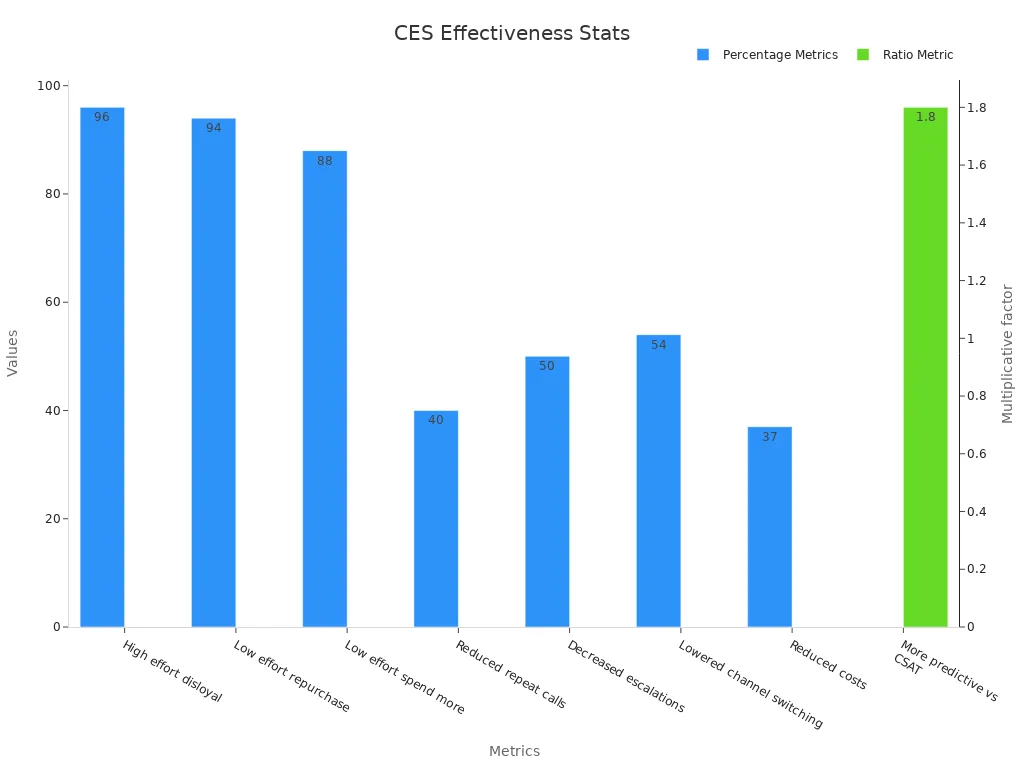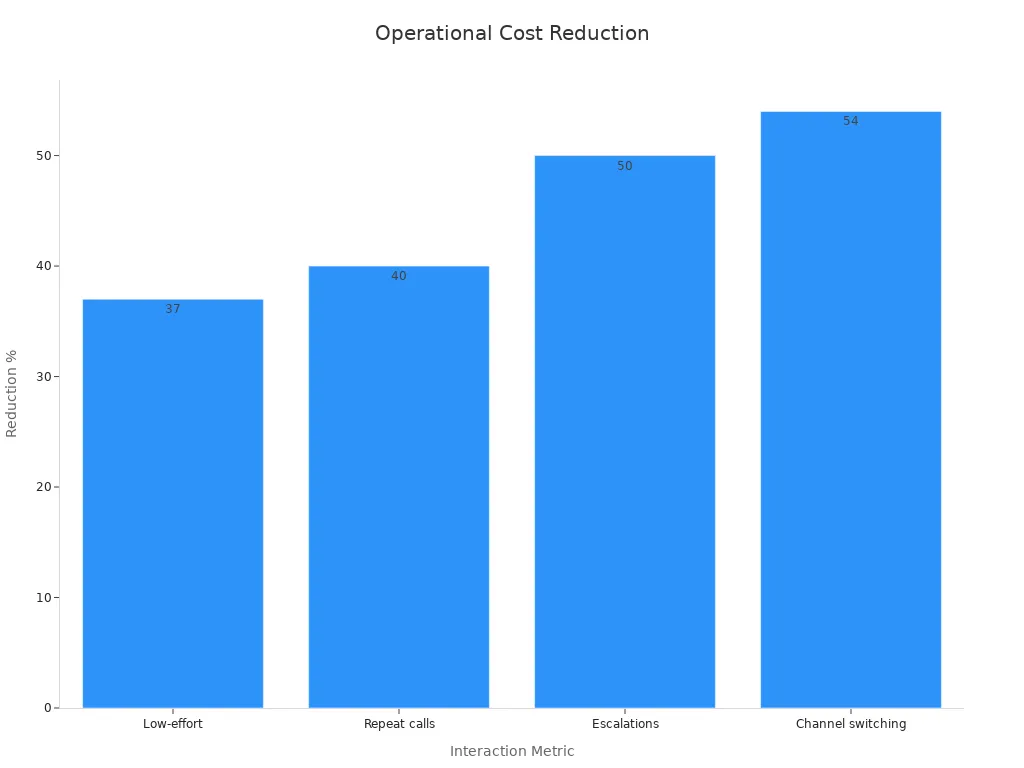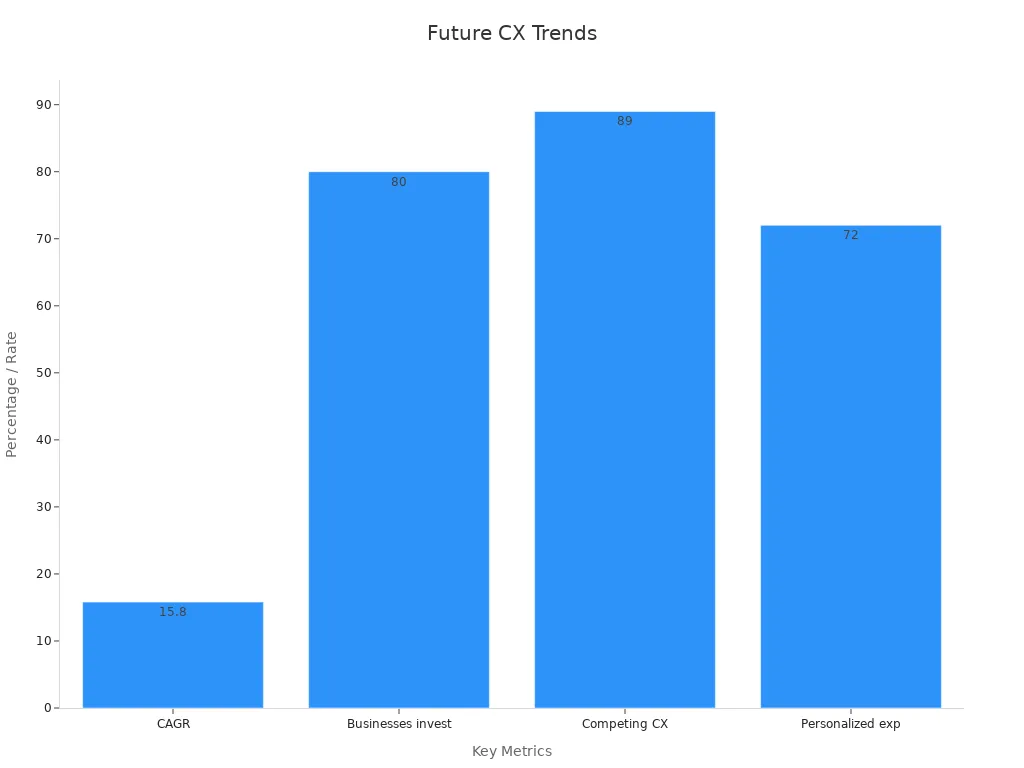Customer Effort Score Insights for 2025

Customer Effort Score (CES) measures how easy it is for you to interact with a business, whether resolving issues or completing purchases. This customer experience metric focuses on reducing the effort required during these interactions, and understanding the customer effort score benchmark is essential for businesses aiming to improve their services. When businesses minimize customer effort, they create smoother experiences that lead to stronger loyalty.
In 2025, CES will play a pivotal role in shaping how businesses succeed. Over 60% of customers leave brands due to frustrating issue resolution, highlighting the importance of effortless customer service. Companies with high CES scores see a 94% likelihood of repeat purchases. Additionally, reducing effort improves operational efficiency, as customers spend 42% less time resolving issues. By prioritizing CES and utilizing tools like Sobot, you can gain a competitive edge and enhance retention.
What Is Customer Effort Score (CES)?

Definition and Purpose of CES
Customer Effort Score (CES) is a customer experience metric that evaluates how easy it is for your customers to interact with your business. Whether they’re resolving an issue, making a purchase, or seeking support, CES focuses on the effort required to complete these tasks. Unlike traditional satisfaction metrics, CES zeroes in on reducing friction in customer interactions.
Research by the Corporate Executive Board (CEB) in the late 2000s revealed that customers are more likely to stay loyal when their experiences require minimal effort. This insight shifted the focus from delighting customers to simplifying their journeys. For example, grocery delivery services now prioritize CES to streamline ordering and issue resolution, ensuring you can shop effortlessly. Similarly, telecom providers use CES to address common complaints about accessing help, making it easier for you to resolve issues without frustration.
By measuring CES, businesses can identify pain points and implement solutions that make your experience smoother. This approach not only boosts customer loyalty but also reduces operational inefficiencies, such as repeat calls or escalations.
How CES Differs from Other Metrics
Customer Effort Score stands apart from other metrics like Net Promoter Score (NPS) and Customer Satisfaction Score (CSAT). While NPS measures your likelihood of recommending a brand and CSAT gauges your overall satisfaction, CES focuses solely on the ease of completing a specific task. For instance, CES might ask, “How easy was it to get the help you needed?” This direct approach highlights areas where your experience could improve.
A key difference lies in its predictive power. Studies show CES is 1.8 times more effective than CSAT at predicting customer loyalty. High-effort interactions often lead to disloyalty, with 96% of customers walking away after a frustrating experience. On the other hand, low-effort interactions encourage repeat purchases, with 94% of customers likely to buy again. This makes CES a critical tool for businesses aiming to enhance your experience while fostering long-term loyalty.
| Statistic | Description |
|---|---|
| 96% | Customers with high-effort interactions become disloyal. |
| 94% | Customers who reported low effort are likely to repurchase. |
| 1.8x | CES is more predictive of customer loyalty than CSAT. |
| 88% | Customers experiencing low effort are likely to spend more. |
| 40% | CES has reduced repeat calls. |
| 50% | CES has decreased escalations. |
| 54% | CES has lowered channel switching. |
| 37% | CES has reduced costs. |

Why CES Is Essential for 2025
The importance of measuring CES has never been greater. In 2025, businesses face increasing pressure to deliver seamless experiences. Customers expect quick resolutions, intuitive self-service options, and minimal effort when interacting with brands. CES helps you identify and eliminate barriers, ensuring your journey is as smooth as possible.
Low-effort experiences also drive significant business benefits. For example, CES has been shown to reduce repeat calls by 40%, lower escalations by 50%, and decrease channel switching by 54%. These improvements not only enhance your satisfaction but also cut operational costs. Moreover, businesses that prioritize CES often lead the way in customer-centric innovation. By focusing on ease of use, they develop tools and processes that make your life easier, such as AI-driven chatbots or streamlined checkout systems.
Sobot, for instance, leverages CES insights to refine its customer support solutions. By integrating AI tools and predictive analytics, Sobot ensures you receive fast, efficient assistance. This commitment to reducing effort sets a new standard for customer experience, making CES a cornerstone of business success in 2025.
How to Measure Customer Effort Score
Key Elements of a Customer Effort Score Survey
To conduct a CES survey effectively, you need to focus on a few essential elements. These components ensure the survey captures accurate and actionable feedback from your customers. Here's a breakdown of the key elements:
| Key Element | Description |
|---|---|
| Define customer interactions | Identify key interactions that impact customer satisfaction, such as purchases and support contacts. |
| Create clear survey questions | Ask straightforward questions to gauge effort, avoiding ambiguity. |
| Choose the right scale | Use a consistent rating scale (1-5 or 1-7) to measure effort effectively. |
| Use a variety of distribution channels | Distribute surveys via email, in-app pop-ups, or SMS for timely feedback. |
| Ensure timing is appropriate | Send surveys immediately after interactions to capture accurate feedback. |
When designing your CES survey, focus on simplicity. For example, a CES question like, "How easy was it to resolve your issue today?" provides clear insights into customer effort. Using a 5-point or 7-point Likert scale ensures consistency in responses. Additionally, distributing surveys through multiple channels, such as email or in-app notifications, increases the likelihood of receiving timely feedback.
Methods for Calculating CES
Measuring CES involves a straightforward process, but the methodology you choose can impact the accuracy of your results. Here are some validated methods:
- Design your CES survey with a single, clear question to uncover friction points in specific customer interactions.
- Use a 5-point Likert scale for responses, ranging from "Very Easy" to "Very Difficult."
- Optimize your surveys for mobile devices to improve response rates and data accuracy.
To calculate the customer effort score, follow these steps:
- Survey customers immediately after specific interactions, such as resolving an issue or completing a purchase.
- Sum all the effort scores collected from the survey responses.
- Divide the total by the number of responses to get the average score.
For example, if 100 customers respond to your CES survey and the total score is 300, the average CES score would be 3. A lower score indicates less effort and a better experience. According to Gartner research, CES surveys are 40% more accurate in predicting customer loyalty than traditional satisfaction metrics like CSAT.
Best Practices for Collecting CES Data
To gather and analyze CES data effectively, you need to follow best practices that ensure accuracy and actionable insights. Here are some tips:
- Keep it Simple: Ask a single, focused question in your CES survey, such as, "How easy was it to resolve your issue today?" This approach minimizes confusion and encourages honest feedback.
- Timing is Key: Send the survey immediately after a customer interaction. This timing captures the customer's immediate reaction, leading to more accurate responses.
- Optimize for Mobile: Ensure your CES surveys are mobile-friendly. This step improves response rates and ensures you collect data from a broader audience.
Once you collect the data, calculate the average score to assess overall customer effort. Look for patterns in the responses to identify pain points. For instance, if many customers report high effort during checkout, you can streamline the process to improve their experience. Acting on feedback is crucial. Use the insights to make changes that reduce effort and enhance satisfaction.
Sobot, for example, uses CES data to refine its customer support tools. By integrating AI-driven analytics, Sobot identifies areas where customers face challenges and implements solutions to simplify their journey. This proactive approach not only improves CES scores but also strengthens customer loyalty.
Customer Effort Score Benchmark: What Constitutes a Good CES?
Industry Standards and Benchmarks
Understanding the customer effort score benchmark helps you evaluate how your business compares to industry standards. A good CES typically falls between 4 and 5 on a 5-point scale or 6 and 7 on a 7-point scale. These scores indicate that customers find interactions with your business easy and hassle-free.
Different industries have varying benchmarks. For example, e-commerce platforms often aim for CES scores above 4.5 due to their focus on seamless checkout processes. On the other hand, industries like healthcare may have slightly lower benchmarks, as resolving complex issues often requires more effort. Tracking these benchmarks allows you to identify areas for improvement and align your efforts with customer expectations.
Tip: Regularly compare your CES scores with industry averages to ensure your business stays competitive.
Factors That Influence CES Scores
Several factors impact your customer effort score. The complexity of your processes plays a significant role. If customers struggle to navigate your website or resolve issues, CES scores will drop. Similarly, the availability of self-service options influences effort levels. Tools like FAQs, chatbots, and intuitive interfaces reduce the need for human intervention, improving scores.
Customer expectations also shape CES outcomes. In 2025, customers demand faster resolutions and personalized experiences. Businesses that fail to meet these expectations often see lower scores. Additionally, the timing of surveys affects results. Surveys sent immediately after interactions capture accurate feedback, while delays may lead to skewed responses.
Examples of Good CES Scores Across Industries
High CES scores reflect a commitment to reducing customer effort. In the retail sector, companies like Amazon consistently achieve scores above 4.5 by offering one-click purchasing and efficient delivery tracking. In the tech industry, Apple excels with CES scores around 4.7 due to its user-friendly support systems and streamlined product setup.
Healthcare providers also demonstrate strong CES performance. Telemedicine platforms, for instance, achieve scores above 4.3 by simplifying appointment scheduling and offering virtual consultations. These examples highlight how businesses across industries leverage CES insights to enhance customer experiences.
Note: Striving for a high customer effort score benchmark ensures your business remains customer-centric and competitive.
Why CES Matters for Businesses in 2025
CES and Its Impact on Customer Loyalty and Retention
Customer Effort Score (CES) directly influences customer loyalty and retention. When you encounter low-effort experiences, you’re more likely to stay loyal to a brand. Studies show that 94% of customers who report minimal effort during interactions make repeat purchases. Conversely, high-effort experiences often lead to churn, with 96% of customers leaving after frustrating interactions.
CES serves as a powerful customer satisfaction metric by identifying friction points in customer touchpoints. For example, if you struggle to resolve issues through customer service, CES highlights areas for improvement. Businesses that act on customer feedback analysis can minimize customer churn and foster long-term loyalty. Tools like Sobot’s AI-driven analytics help businesses refine customer journey touchpoints, ensuring smoother interactions and higher retention rates.
How CES Reduces Operational Costs
Improving CES doesn’t just enhance customer satisfaction; it also reduces operational costs. Low-effort experiences decrease repeat calls by 40%, escalations by 50%, and channel switching by 54%. These reductions translate into significant cost savings for businesses.
| Interaction Type | Cost Difference |
|---|---|
| Low-Effort | 37% less |
| High-Effort | - |

By monitoring CES alongside other KPIs, you can identify inefficiencies and streamline processes. For instance, Sobot uses CES insights to optimize customer service workflows, reducing unnecessary escalations and improving response times. This approach not only lowers costs but also enhances customer engagement.
CES as a Driver of Customer-Centric Innovation
CES drives innovation by encouraging businesses to focus on customer needs. When you provide feedback about high-effort interactions, companies can use this data to develop solutions that simplify processes. For example, CES insights have led to the creation of AI-powered chatbots, self-service portals, and intuitive interfaces that reduce effort across customer touchpoints.
Customer experience analytics transforms data into actionable improvements. Businesses that prioritize CES often lead in customer-centric innovation, creating tools that enhance your experience. Sobot exemplifies this by leveraging CES data to refine its products, ensuring you receive seamless support and effortless resolutions. By focusing on CES, businesses can stay ahead of customer expectations and foster satisfaction.
CES vs NPS vs CSAT: Understanding the Differences
Overview of CES, NPS, and CSAT
Understanding the differences between CES, NPS, and CSAT helps you choose the right metric for your business goals. Each serves a unique purpose in evaluating customer feedback.
- Customer Effort Score (CES) measures how easy it is for customers to complete a task, such as resolving an issue or making a purchase. It focuses on specific interactions and highlights areas where processes can improve.
- Net Promoter Score (NPS) gauges customer loyalty by asking how likely they are to recommend your business. It provides a long-term view of customer relationships but can fluctuate if not measured consistently.
- Customer Satisfaction Score (CSAT) assesses satisfaction with a product or service at specific touchpoints. It identifies immediate areas for improvement in customer experience.
| Metric | Purpose | Focus | Insights |
|---|---|---|---|
| CES | Measures the effort required by customers to complete a task | Specific interactions | Highlights areas needing improvement in customer processes |
| NPS | Gauges customer loyalty and likelihood to recommend | Long-term view | Tracks customer loyalty trends over time |
| CSAT | Assesses customer satisfaction with products/services | Specific scenarios | Identifies immediate areas for enhancement in customer experience |
Unique Value of CES in Measuring Customer Effort
CES stands out because it directly addresses the ease of customer interactions. Unlike NPS, which takes a broader view of loyalty, or CSAT, which measures general satisfaction, CES pinpoints friction in specific processes. For example, if customers find it difficult to navigate your website or resolve issues through customer service, CES highlights these pain points.
Studies show that CES is closely tied to customer loyalty. Low-effort interactions increase the likelihood of repeat purchases by 94%, while high-effort experiences drive 96% of customers away. This makes CES a powerful tool for identifying and fixing barriers that impact customer retention.
Businesses like Sobot use CES insights to refine their customer service tools. By analyzing CES data, Sobot identifies areas where customers face challenges and implements solutions, such as AI-driven chatbots, to simplify interactions. This approach not only improves CES scores but also enhances overall customer satisfaction.
When to Use CES Over Other Metrics
You should use CES when your goal is to reduce friction in specific customer interactions. For instance, if you want to improve the ease of resolving issues or completing purchases, CES provides actionable insights. It’s especially useful for businesses focused on streamlining processes and enhancing customer service efficiency.
In contrast, NPS works better for tracking long-term loyalty trends, while CSAT is ideal for gauging satisfaction with a particular product or service. Combining these metrics can give you a comprehensive view of customer experience. However, if your priority is to make interactions effortless, CES should be your go-to metric.
Strategies to Improve Customer Effort Score

Leveraging AI Tools for Better Customer Support
AI tools have revolutionized customer service by making interactions faster and more efficient. These tools analyze customer queries, predict needs, and provide instant solutions. For example, Amazon's AI-powered support system reduced its Customer Effort Score (CES) by 32%, improved customer satisfaction from 84% to 94%, and cut repeat contact rates by 45%. This demonstrates how AI can simplify problem resolution and enhance overall satisfaction.
You can adopt AI-driven chatbots to handle routine inquiries, freeing up human agents for complex issues. Tools like Sobot’s AI-powered solutions excel in this area. They use predictive analytics to identify common pain points and offer real-time assistance. By integrating such tools, you can improve customer effort score while ensuring faster resolutions and better experiences.
Tip: Use AI to personalize interactions. Customers appreciate tailored responses that address their specific needs.
Enhancing Self-Service Options
Self-service options empower customers to solve problems independently, reducing the need for direct support. Features like FAQs, knowledge bases, and self-checkout systems make processes more convenient. Studies show that self-checkout systems not only reduce perceived effort but also increase customer loyalty when viewed as rewarding.
Implementing intuitive self-service tools can significantly improve customer effort score. For instance, Sobot offers self-service portals that guide users through common issues step-by-step. These tools ensure customers find answers quickly, minimizing frustration. By enhancing self-service options, you can create a seamless experience that fosters loyalty and satisfaction.
- Benefits of self-service options:
- Faster issue resolution.
- Reduced dependency on customer service agents.
- Increased customer confidence in your brand.
Streamlining Processes to Reduce Customer Effort
Simplifying processes is key to reducing customer effort. Complex workflows or unclear instructions often frustrate customers, leading to higher CES scores. Data shows that 88% of customers are likely to spend more after an effortless experience, while 94% intend to repurchase following low-effort interactions.
You can streamline processes by identifying bottlenecks and eliminating unnecessary steps. For example, Sobot uses CES data to refine customer service workflows, ensuring smoother interactions. Whether it’s optimizing your website’s navigation or simplifying your checkout process, these improvements can make a significant impact.
| Improvement Strategy | Impact on Customer Effort |
|---|---|
| Ensure Effortless Experience | 88% of customers likely to spend more after an effortless experience. |
| Improves Repurchase Rate | 94% of customers intend to repurchase after low-effort service interactions. |
| Reduce Cost | CES has led to a 40% decline in repeat calls, 50% in escalations, and 54% in channel switching, reducing costs by 37%. |
Note: Regularly review customer feedback to identify areas where processes can be simplified.
Customer Effort Score (CES) will define how businesses succeed in 2025. By reducing effort in customer interactions, you can improve loyalty, retention, and operational efficiency. Companies that prioritize CES often lead in customer-centric innovation, creating tools that simplify your experience.
Future trends highlight CES as a cornerstone of customer experience management. The global market for customer experience management reached $12.04 billion in 2023, with a projected CAGR of 15.8% through 2030. By 2025, 89% of companies will compete primarily on customer experience, while 72% of customers expect personalized interactions.
| Statistic | Value |
|---|---|
| Global market for customer experience management in 2023 | $12.04 billion |
| Projected CAGR from 2024 to 2030 | 15.8% |
| Percentage of businesses planning to increase CX investment | 80% |
| Percentage of companies competing primarily on CX by 2025 | 89% |
| Percentage of customers expecting personalized experiences | 72% |

AI-driven analytics and predictive tools will shape CES strategies. These technologies help you identify friction points and deliver seamless experiences. By focusing on CES, you can stay ahead of customer expectations and secure long-term success.
FAQ
What is the ideal time to send a CES survey?
You should send a CES survey immediately after a customer interaction. This timing ensures you capture accurate feedback while the experience is still fresh in their mind. Delayed surveys may lead to less reliable responses.
Can CES be used alongside NPS and CSAT?
Yes, CES complements NPS and CSAT. While CES measures effort, NPS tracks loyalty, and CSAT gauges satisfaction. Using all three metrics provides a comprehensive view of customer experience, helping you identify areas for improvement and track long-term trends.
How can AI improve CES?
AI simplifies customer interactions by providing instant solutions. Tools like chatbots and predictive analytics reduce effort by addressing common issues quickly. For example, AI can guide customers through troubleshooting steps, improving their experience and lowering CES scores.
What industries benefit most from CES?
Industries with frequent customer interactions, like retail, telecom, and healthcare, benefit greatly from CES. These sectors rely on seamless processes to retain customers. For example, e-commerce platforms use CES to optimize checkout and delivery experiences.
How does CES impact operational costs?
Low-effort experiences reduce repeat calls, escalations, and channel switching. These improvements lower operational costs by streamlining workflows and minimizing resource use. For instance, businesses that prioritize CES often see a 37% reduction in support costs.
See Also
Best Customer Feedback Software Options for 2024
Discovering Leading Cloud-Based Contact Centers for 2025
Comprehensive Reviews of Contact Center Solutions for 2024
